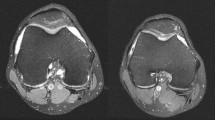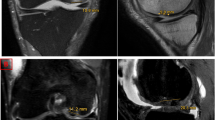Abstract
Purpose
The purpose of this study was to evaluate the changes in the site-specific cartilage status after a double-bundle ACL reconstruction using preoperative and follow-up MR images.
Methods
Thirty-six knees that underwent a double-bundle ACL reconstruction from 2001 to 2009 with the available preoperative and follow-up magnetic resonance imaging were included. Patients with a meniscal injury were compared with those without a meniscal injury. The cartilage morphology was classified using a 6-grade scale [from 0 = normal thickness and signal, to 6 = diffuse full-thickness loss (>75 % of the region)]. The changes in cartilage status were evaluated at 14 sites.
Results
Cartilage changes were observed in all sites and were classified according to the site and degree of change. The majority of changes were grade 0 and 1, which accounted for 68 and 16.8 % of changes, respectively. The patella medial facet and anterolateral and centromedial femoral regions showed significantly more cartilage loss than the posteromedial, centrolateral, anterolateral, and anteromedial tibial regions. No significance was observed between the knees with or without combined injuries (n.s.). On the other hand, knees with or without combined injuries showed a different pattern of cartilage change, as demonstrated by different levels of grade change at sites.
Conclusions
The change in cartilage status was minimal after a double-bundle ACL reconstruction. The patella medial facet, lateral femur anterior region, and medial femur central region showed significantly more cartilage loss than the medial tibia posterior, lateral tibia central, lateral tibia anterior, and medial tibia anterior regions. The presence of a combined injury did not affect the cartilage status changes, even though it was underpowered and too short term to assess the influence of the meniscal injury.
Level of evidence
Case series, Level IV.




Similar content being viewed by others
References
Aglietti P, Giron F, Cuomo P, Losco M, Mondanelli N (2007) Single-and double-incision double-bundle ACL reconstruction. Clin Orthop Relat Res 454:108–113
Amin S, Guermazi A, Lavalley MP, Niu J, Clancy M, Hunter DJ, Grigoryan M, Felson DT (2008) Complete anterior cruciate ligament tear and the risk for cartilage loss and progression of symptoms in men and women with knee osteoarthritis. Osteoarthritis Cartilage 16:897–902
Amin S, LaValley MP, Guermazi A, Grigoryan M, Hunter DJ, Clancy M, Niu J, Gale DR, Felson DT (2005) The relationship between cartilage loss on magnetic resonance imaging and radiographic progression in men and women with knee osteoarthritis. Arthritis Rheum 52:3152–3159
Borchers JR, Kaeding CC, Pedroza AD, Huston LJ, Spindler KP, Wright RW (2011) Intra-articular findings in primary and revision anterior cruciate ligament reconstruction surgery: a comparison of the MOON and MARS study groups. Am J Sports Med 39:1889–1893
Debandi A, Maeyama A, Lu S, Hume C, Asai S, Goto B, Hoshino Y, Smolinski P, Fu FH (2011) Biomechanical comparison of three anatomic ACL reconstructions in a porcine model. Knee Surg Sports Traumatol Arthrosc 19:728–735
Delince P, Ghafil D (2011) Anterior cruciate ligament tears: conservative or surgical treatment? A critical review of the literature. Knee Surg Sports Traumatol Arthrosc 20:48–61
Forsythe B, Kopf S, Wong AK, Martins CA, Anderst W, Tashman S, Fu FH (2010) The location of femoral and tibial tunnels in anatomic double-bundle anterior cruciate ligament reconstruction analyzed by three-dimensional computed tomography models. J Bone Jt Surg Am 92:1418–1426
Fujita N, Kuroda R, Matsumoto T, Yamaguchi M, Yagi M, Matsumoto A, Kubo S, Matsushita T, Hoshino Y, Nishimoto K, Araki D, Kurosaka M (2011) Comparison of the clinical outcome of double-bundle, anteromedial single-bundle, and posterolateral single-bundle anterior cruciate ligament reconstruction using hamstring tendon graft with minimum 2-year follow-up. Arthroscopy 27:906–913
Hantes ME, Liantsis AK, Basdekis GK, Karantanas AH, Christel P, Malizos KN (2010) Evaluation of the bone bridge between the bone tunnels after anatomic double-bundle anterior cruciate ligament reconstruction: a multidetector computed tomography study. Am J Sports Med 38:1618–1625
Holm I, Oiestad BE, Risberg MA, Aune AK (2011) No difference in knee function or prevalence of osteoarthritis after reconstruction of the anterior cruciate ligament with 4-strand hamstring autograft versus patellar tendon-bone autograft: a randomized study with 10-year follow-up. Am J Sports Med 38:448–454
Jepsen CF, Lundberg-Jensen AK, Faunoe P (2007) Does the position of the femoral tunnel affect the laxity or clinical outcome of the anterior cruciate ligament-reconstructed knee? A clinical, prospective, randomized, double-blind study. Arthroscopy 23:1326–1333
Lee S, Kim H, Jang J, Seong SC, Lee MC (2012) Comparison of anterior and rotatory laxity using navigation between single- and double-bundle ACL reconstruction: prospective randomized trial. Knee Surg Sports Traumatol Arthrosc 20:752–761
Losee RE (1983) Concepts of the pivot shift. Clin Orthop Relat Res 172:45–51
Morimoto Y, Ferretti M, Ekdahl M, Smolinski P, Fu FH (2009) Tibiofemoral joint contact area and pressure after single- and double-bundle anterior cruciate ligament reconstruction. Arthroscopy 25:62–69
Peterfy CG, Guermazi A, Zaim S, Tirman PF, Miaux Y, White D, Kothari M, Lu Y, Fye K, Zhao S, Genant HK (2004) Whole-organ magnetic resonance imaging score (WORMS) of the knee in osteoarthritis. Osteoarthritis Cartilage 12:177–190
Pinczewski LA, Salmon LJ, Jackson WF, von Bormann RB, Haslam PG, Tashiro S (2008) Radiological landmarks for placement of the tunnels in single-bundle reconstruction of the anterior cruciate ligament. J Bone Jt Surg Br 90:172–179
Plaweski S, Grimaldi M, Courvoisier A, Wimsey S (2011) Intraoperative comparisons of knee kinematics of double-bundle versus single-bundle anterior cruciate ligament reconstruction. Knee Surg Sports Traumatol Arthrosc 19:1277–1286
Sonnery-Cottet B, Lavoie F, Ogassawara R, Kasmaoui H, Scussiato RG, Kidder JF, Chambat P (2010) Clinical and operative characteristics of cyclops syndrome after double-bundle anterior cruciate ligament reconstruction. Arthroscopy 26:1483–1488
Tajima G, Iriuchishima T, Ingham SJ, Shen W, van Houten AH, Aerts MM, Shimamura T, Smolinski P, Fu FH (2010) Anatomic double-bundle anterior cruciate ligament reconstruction restores patellofemoral contact areas and pressures more closely than nonanatomic single-bundle reconstruction. Arthroscopy 26:1302–1310
Takeda Y, Sato R, Ogawa T, Fujii K, Naruse A (2009) In vivo magnetic resonance imaging measurement of tibiofemoral relation with different knee flexion angles after single- and double-bundle anterior cruciate ligament reconstructions. Arthroscopy 25:733–741
Van Eck CF, Fu FH (2011) We have to eliminate nonanatomic anterior cruciate ligament tunnel placement as a cause of osteoarthritis. Arthroscopy 27:601–602
Yang SH, Sim JA, Kwak JH, Kim BK, Ahn BM, Lee BK (2010) 7 to 22Y follow-up of anterior cruciate ligament reconstruction: from the standpoint of OA. J Korean Arthrosc Soc 14:20–24
Yasuda K, Kondo E, Ichiyama H, Tanabe Y, Tohyama H (2006) Clinical evaluation of anatomic double-bundle anterior cruciate ligament reconstruction procedure using hamstring tendon grafts: comparisons among 3 different procedures. Arthroscopy 22:240–251
Author information
Authors and Affiliations
Corresponding author
Rights and permissions
About this article
Cite this article
Lee, Y.S., Jeong, Y.M., Sim, J.A. et al. Specific compartmental analysis of cartilage status in double-bundle ACL reconstruction patients: a comparative study using pre- and postoperative MR images. Knee Surg Sports Traumatol Arthrosc 21, 702–707 (2013). https://doi.org/10.1007/s00167-012-2046-y
Received:
Accepted:
Published:
Issue Date:
DOI: https://doi.org/10.1007/s00167-012-2046-y




